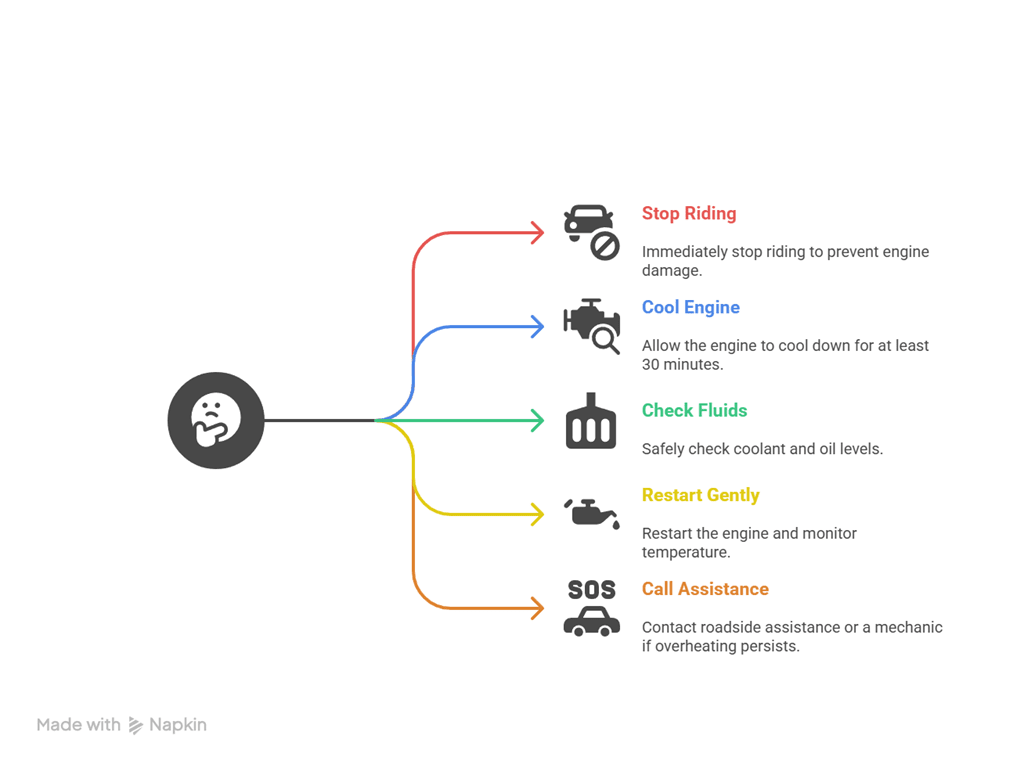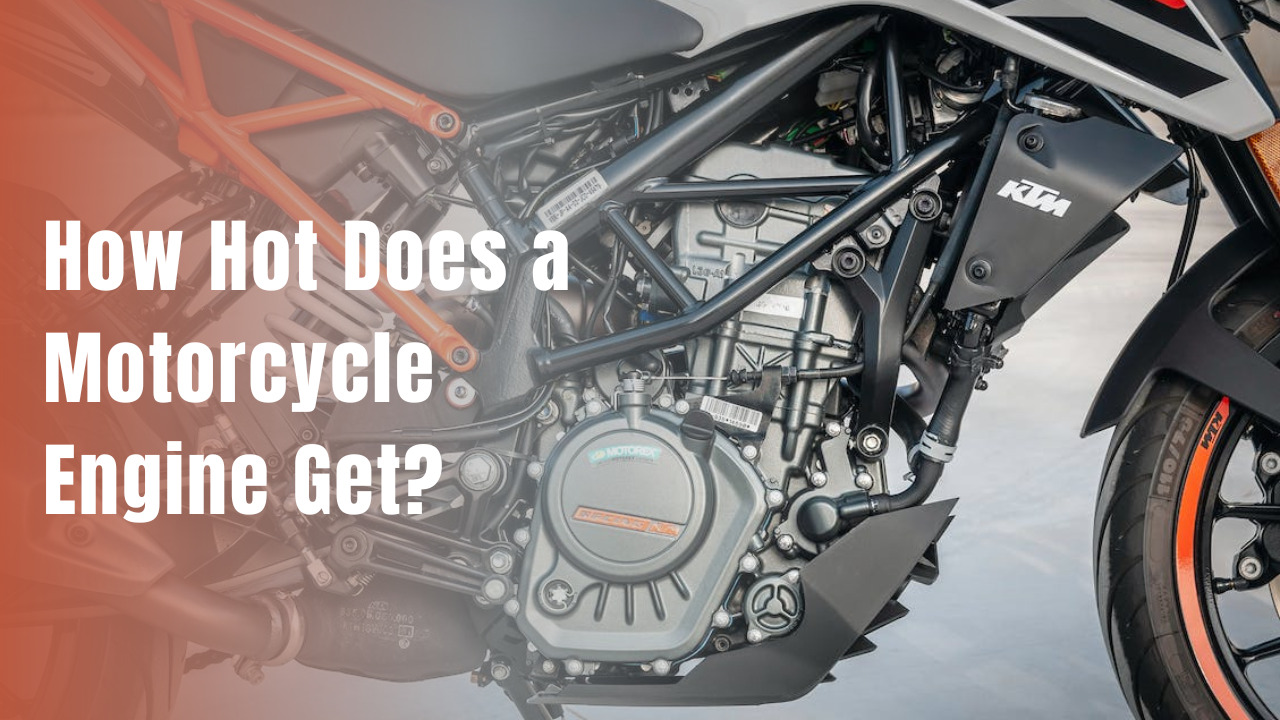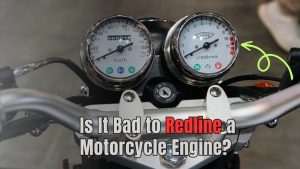🎯 Key Takeaways
- Motorcycle engines typically run between 180°F–220°F under normal riding conditions.
- Overheating often starts at 230°F and can cause severe engine damage if ignored.
- Liquid cooling offers better heat control than air or oil cooling systems.
- Regular maintenance and fluid checks are the best ways to prevent overheating.
Last summer, I was stuck in bumper-to-bumper traffic on a 95°F day, riding my Yamaha MT-07. My thighs were on fire, the fan was screaming, and I glanced down to see the temp gauge climbing past 220°F. It got me thinking, how hot is too hot for a motorcycle engine?
When riding in hot summer days, we’ve all felt that our bike radiating heat like a barbecue grill. Whether you’re riding a high-revving sportbike, a classic air-cooled cruiser, or something in between, knowing how hot a motorcycle engine gets, and how to manage it, is essential for performance, safety, and longevity.
In this guide, I’ll break down:
- What counts as a “normal” engine temperature
- How different bikes (like the MT-07) manage heat
- Signs your engine’s overheating
- What causes high temps
- And how to keep your ride running cool—even on the hottest days
How Hot Does a Motorcycle Engine Get?
On average, motorcycle engine temperatures range from 180°F to 220°F (82°C to 104°C) when operating under normal conditions.
However, this varies depending on several factors:
- Air-cooled engines often run hotter than liquid-cooled ones.
- Oil temperatures can reach 250°F+, especially under high-stress riding.
- In extreme situations (like dyno testing or long idling in summer), temperatures can reach 250°F–300°F (121°C–149°C) in localized areas such as the cylinder head.
What Affects Motorcycle Engine Heat
Several factors contribute to how hot your engine gets—and how well it handles that heat.
1. Cooling System Type
- Air-cooled engines rely on airflow over cooling fins. In traffic or hot climates, this system struggles to regulate heat.
- Oil-cooled engines circulate oil through external coolers, offering better heat regulation than air but less than liquid systems.
- Liquid-cooled engines use coolant circulated through a radiator, which is the most effective under varied conditions.
2. Ambient Temperature
Riding on a 95°F summer day vs. a 55°F morning can change engine temps by 10–20°F. Hot ambient air reduces the temperature difference needed for effective cooling.
3. Engine Type & Size
- Sportbikes and high-revving engines run hotter due to their power output.
- Cruisers and touring bikes may run cooler but are heavier and can suffer in traffic.
4. Riding Conditions
- Stop-and-go traffic, idling, and climbing steep hills heat up engines faster than steady-speed cruising.
- Riding in high altitudes? Expect temperatures to rise 5–10°F due to thinner air and reduced cooling efficiency.
5. Fluid Condition
- Old or contaminated oil and degraded coolant reduce the engine’s ability to shed heat.
- A dirty radiator or blocked airflow path can also trap heat.
Signs Your Motorcycle Is Overheating
Spotting overheating early can save you from major engine damage. Look out for:
- Temperature gauge above 230°F
- Steam from radiator, hoses, or engine bay
- Engine knocking or pinging (pre-detonation sounds)
- Loss of power, misfiring, or stalling
- Burning smells or super-hot exhaust parts
- Boiling coolant in overflow tank
Common Causes of Motorcycle Engine Overheating
Understanding what leads to excess heat helps prevent it.
Most common culprits:
- Low or old coolant
- Low or degraded engine oil
- Clogged or dirty radiator
- Broken or weak radiator fan
- Leaking head gaskets or seals
- Faulty thermostat
- Water pump failure
- Lean air/fuel mixtures
- Restricted airflow due to debris or fairing design
What to Do If Your Bike Overheats
If your temperature gauge hits 230–250°F or higher, STOP RIDING immediately. Here’s what to do:

- Pull over safely and shut off the engine.
- Don’t remove the radiator cap, you could be scalded.
- Let the engine cool for at least 30 minutes.
- Check fluid levels (coolant and oil) once it’s safe to do so.
- If nothing obvious is wrong, restart gently and monitor.
- Still overheating? Call roadside assistance or a mechanic.
How to Prevent Motorcycle Overheating
Simple routine care can drastically reduce your chances of running hot.
Maintenance Tips:
- Check coolant and oil levels weekly
- Replace coolant every 2 years (or as recommended)
- Clean radiator fins regularly
- Inspect and clean fans and hoses
- Use high-quality oil and coolant brands (e.g., Engine Ice, AMSOIL)
- Avoid prolonged idling, especially in summer
- Adjust riding style, avoid hard acceleration in dense traffic
Final Words
We hope this breakdown of engine temps gave you some useful info to keep your ride running cool. How hot does a motorcycle engine get? The normal range is 150-220°F, but watch for signs like steam or pinging if it hits the high 230s.
Also, keep an eye on fluid levels, fan and pump function, and avoid baking your bike in traffic. With some regular maintenance love like we discussed, you’ll be preventing overheating issues before they even start. Ride safe out there and keep that gauge in the green zone!
FAQs: How Hot Does a Motorcycle Engine Get?
What’s the normal operating temperature for a motorcycle engine?
Most motorcycle engines run between 180 °F–220 °F (82 °C–104 °C) for optimal performance and efficiency.
At what temperature does a motorcycle engine start overheating?
Generally, temps above 230 °F (110 °C) signal overheating. Anything above 240–260 °F becomes critical and requires immediate action.
What common signs show the engine is overheating?
Key indicators include steam from the engine, odor of burning oil, engine pinging, loss of power, or rapid gauge climb.
How can I prevent my motorcycle from overheating?
Keep coolant and oil topped up, clean radiator fins, avoid prolonged idling/heavy loads, ride in cooler times, and stick to regular maintenance.
How hot does a motorcycle cylinder head typically run?
Cylinder head temps usually range between 149 °F–230 °F (65 °C–110 °C), varying with engine type and riding conditions.




